Using Wastes of Opuntia ficus-indica in Diets of Nile Tilapia
An indoor feeding experiment was conducted to evaluate the effects on all-males mono-sex Nile tilapia (17 g initial body weight and a total length of 9.2 cm) of replacing diet's corn by meals of fruit skin and leaves of Teen Barshomy (Teen Shoky) "Opuntia ficus-indica". Five experimental diets were formulated to replace 25 and 50% of dietary corn by fig skins and fig leaves in diets (D) No. 2, 3, 4, and 5, respectively besides the control one (diet No. 1). All experimental diets were formulated and pelleted into sinking diets with an average pellets diameter and length of 2mm and 1 cm, respectively. Diets were offered to fish 6 days a week at 2 meals (8 am and 2 pm) daily. Glass aquaria (70x35x40cm) were stocked with 10 fish/aquarium. The feeding trial lasted for 75 days at a daily feeding rate 3% of the actual biomass. The obtained results revealed no changes in the rearing water quality criteria. Fig skin and leaves are to some extent chemically similar, but it seems that the fruit skin may be more nutritious than the leaves. The replacement affected the chemical composition of the experimented diets. The dietary inclusion of fig wastes decreased the feed consumption of the experimental diets than the control, improved (P≤0.05) each of FBW, TBG, DBG, SGR, RGR, and FCR as well as whole fish body composition. So, it is possible to feed fish the diets containing fig wastes (25% skin or 50% leaves) as replacers for dietary corn.
Keywords: Teen Shoky, fruit skin, leaves, tilapia performance.
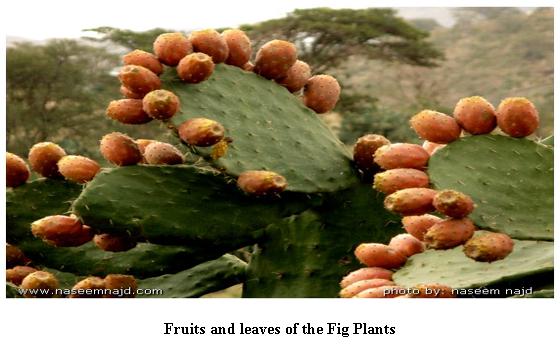
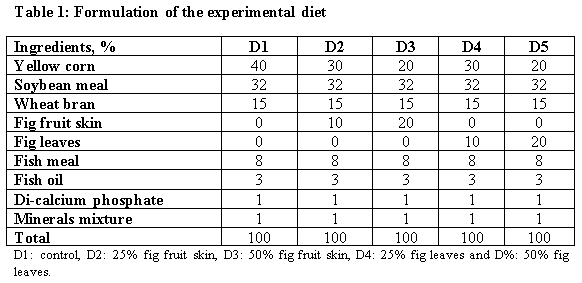
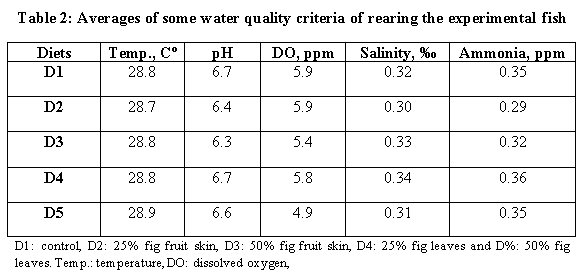
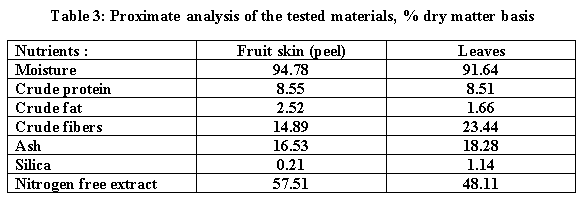

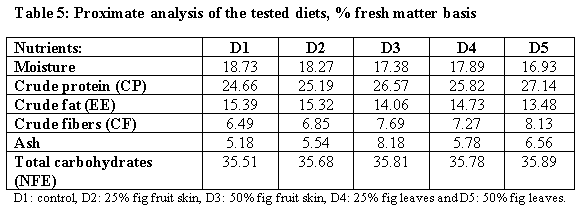


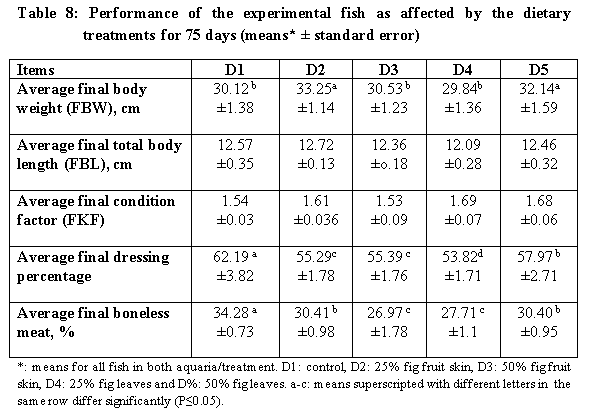

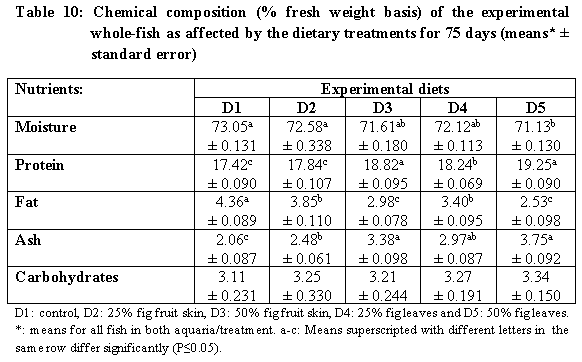
Abdelhamid, A.M. (1996). Field and Laboratorial Analysis in Animal Production. Dar Al-Nashr for the Egyptian Universities. Cairo, 680p., 977-5526-47-7, Deposition No. 11318/1996.
Abdelhamid, A.M. and Saleh, M.T.M. (2015). Evaluation of substituting the sieving wastes of Egyptian clover's seeds instead of soya bean in the diet of Flan-line rabbits. J. Animal and Poultry Prod., Mansoura Univ., 6 (3): 137-147.
Abdelhamid, A. M. and Soliman, A. A. A. (2012). Possibility of using dried leaves of guava and camphor trees in tilapia diets. Journal of the Arabian Aquaculture Society, 7 (1): 91 – 108.
Abdelhamid, A. M. and Soliman, A. A.A. (2013). Comparative evaluation for dietary inclusion of some medicinal plants by common carp fish. Egyptian J. Nutrition and Feeds, 16 (2): 485-499.
Abdelhamid, A.M.; Ismail, R. F. S. A. and Saleh M. T. M. (2016). Evaluation of complete substitution of sieving wastes of the Egyptian clover seeds instead of soybean meal and maize in rabbit's diet. J. Animal and Poultry Prod., Mansoura Univ., 7 (5): 153-162.
Abdelhamid, A. M.; Khalil, F. F. and Mostafa, M. E. A. (2001). Nutritional influences on Nile tilapia (Oreochromis niloticus) brood stock. 4- Growth performance of fry. 2nd Inter. Conf. on Anim. Prod. & Health in Semi-Arid Areas. El- Arish, 4 – 6 Sept., pp: 645 – 654.
Abdelhamid, A. M.; Khalil, F. F. M. and Seden, M. A. A. (2000). Possibility of using dried live yeast and lacto-sacc in Nile tilapia fingerlings’ diets. J. Agric. Sci. Mansoura Univ., 25: 4905-4911.
Abdelhamid, A. M.; Magouz, F. I., El-Mezaien, M. I. B., Abd El-Khalik, A. E., El-Sayed Khlaf Allah, M. M. and Ahmed, E. M. O. (2010a). Effect of source and level of dietary water hyacinth on Nile tilapia Oreochromis niloticus- Histopathology. engormix.com, Aquaculture Technical Article, 19 p.
Abdelhamid, A. M.; Magouz, F. I., El-Mezaien, M. I. B., El-S. Khlafallah, M. M. and Ahmed, E. M. O. (2010b). Effect of source and level of dietary water hyacinth on Nile tilapia, Oreochromis niloticus, performance. J. of Animal and Poultry Production, Mansoura University, 1 (4): 133 – 150.
Abdelhamid, A. M.; Salem, M. F. I. and Rashed, Kh. R. A. E. S. (2018). Effect of dietary inclusion of sieving wastes of the Egyptian clover seeds instead of soybean meal for tilapia. J. Animal and Poultry Prod., Mansoura Univ., 9 (12): 445 – 451.
Abdelhamid, A. M.; Salem, M. F. I. and Tolan, A. E. (2005). Evaluation of linseed meal as feed ingredient in diets on growing Nile tilapia (Oreochromis niloticus). J. Agric. Res. Tanta Univ., 31 (3): 385 – 402.
Ali, B.A. (2008). Effect of total replacement of fish meal by plant protein source and amecozyme on growth performance and feed utilization of monosex Nile tilapia (Oreochromis niloticus) fingerlings. Egtpt. J. of Appl. Sci., 23 (7): 13-24.
AOAC (2000). Association of Official Analytical Chemists of Official Methods of Analysis. 17th Ed., Washington, DC.
Duncan, D.B. (1955). Multiple ranges and multiple F-tests. Biometrics, 11: 1-42.
El-Dakar, A.Y. (2004). Growth response of hybrid tilapia, Oreochromis niloticus x Oreochromis auraus, fingerlings to diets supplemented with different levels of caraway seeds. J. Agric. Sci. Mansoura Univ., 29 (11): 6083-6094.
Eweedah, N.M.; Abd El-Raouf, E.M., Salem, M.F.I., Khalafalla, M.M.E. and Abd El-Aty, B.S. (2006). Replacement of fish meal by fresh water crayfish meal (Procombrus clarkii) in practical diets for Nile tilapia (Oreochromis niloticus). Egypt. J. Agric. Res., 84 (1B): 325-338.
Gaber, M.M. (2006). The effects of plant-protein-based diets supplemented with yucca on growth, digestibility, and chemical composition of Nile tilapia (Oreochromis niloticus, L) fingerlings. Journal of the World Aquaculture Society, 37 (1): 1-8.
Khadr, M.M.E.A. (2018). Using of distillers dried grains with solubles in Nile tilapia fish diet. M.Sc. Thesis, Zagazig Fac. of Agric.
Khalil, F. F.; Abdelhamid, A. M. and Mostafa, M. E. A. (2001). Nutritional influences on Nile tilapia broodstock fish (Oreochromis niloticus). 1- Growth performance and feed utilization. Egypt. J. Nutr. and Feed, 4: 685 – 693.
Mohammed, R.A. and Hanafy, M.A. (2002). Effect of dietary protein and energy levels on growth and body composition of Oreochromis niloticus (L) and Cyprinus carpio (L). Proc. 1st Sc. Conf. Aqua., El-Arish, 13-15 Dec., p: 217-233.
Saad, A.S. (2010). Effect of fermented diets on growth, body composition and survival of Nile tilapia "Oreochromis niloticus". J. Egypt. Ger. Soc. Zool., 61A: Comparative Physiology, 49-62.
SAS (2006). SAS/STAT Guide for personal computer. SAS Inst. Cary, N. C.
Soltan, M.A. (2002). Using of tomato and potato by-products as non-conventional ingredients in Nile tilapia , Oreochromis noliticus diets. Annals of Agric. Sc., Moshtohor, 40 (4): 2081-2096.
Soltan, M.A.; Hanafy, M.A. and Wafa, M.I.A. (2008). An evaluation of fermented silage made from fish by-products as a feed ingredient for African catfish (Clarias gariepinus). Global Veterinaria, 2 (2): 80-86.
Willem Van Cotthem (2012). Juice from the fruit of the prickly pear cactus (Opuntia ficus indica): health-beneficial properties (Alcohol Reports) http://ar.wikipedia.org/w/index.php?title=%D8%AA%D9%8A%D9%86_%D8%B4%D9%88%D9%83%D9%8A&oldid=8369479.
My digital thermometer I use in the room where I started breeding black soldier fly always reads RH between 77 and 89% while it should be 50% and the temperature is within the required range between 27and 30 degrees Celsius. What alternative approaches can help me bring the humidity down? I am in the Eastern part of Nigeria. Thanks.








.jpg&w=3840&q=75)